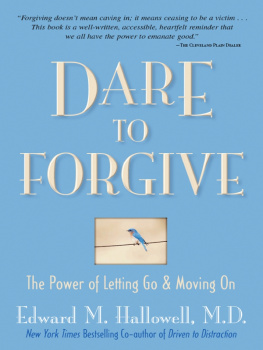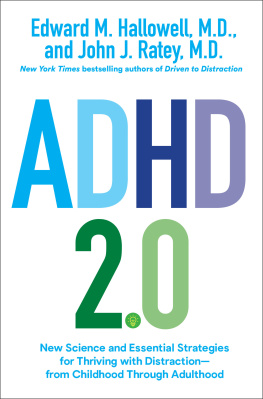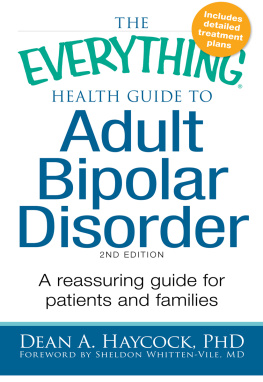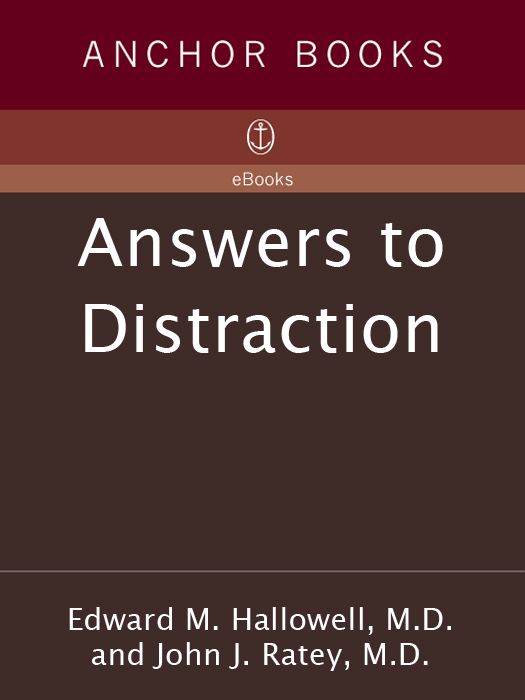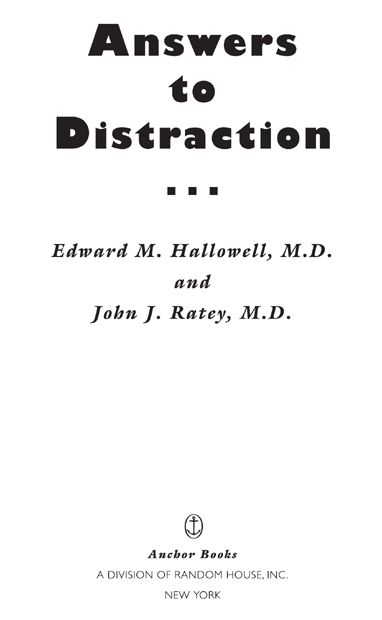About the Authors
E DWARD M. H ALLOWELL , M.D., is in private practice in adult and child psychiatry and has offices in both the Boston area and New York City. He lives with his wife, Sue, and children, Lucy, Jack, and Tucker.
www.drhallowell.com
J OHN J. R ATEY , M.D., is a Clinical Associate Professor of Psychiatry at Harvard Medical School and is in private practice. He lives in the Boston area.
www.johnratey.com
Also by Edward M. Hallowell, M.D., and John J. Ratey, M.D.
Delivered from Distraction: Getting the Most Out of Life with Attention Deficit Disorder
Driven to Distraction: Recognizing and Coping with Attention Deficit Disorder from Childhood Through Adulthood
Also by Edward M. Hallowell, M.D.
CrazyBusy: Overstretched, Overbooked, and About to Snap! Strategies for Handling Your Fast-Paced Life
The Childhood Roots of Adult Happiness: Five Steps to Help Kids Sustain and Create Lifelong Joy
Connect: 12 Vital Ties That Open Your Heart, Lengthen Your Life, and Deepen Your Soul
Dare to Forgive: The Power of Letting Go and Moving On
Finding the Heart of the Child: Essays on Children, Families, and Schools (with Michael Thompson)
Human Moments: How to Find Meaning and Love in Your Everyday Life
Married to Distraction: Restoring Intimacy and Strengthening Your Marriage in an Age of Interruption
Positively ADD: Real Success Stories to Inspire Your Dreams (with Catherine Corman)
Superparenting with ADD: An Innovative Approach to Raising Your Distracted Child (with Peter S. Jensen)
A Walk in the Rain with a Brain
What Are You Worth? (with William J. Grace, Jr.)
When You Worry About the Child You Love: A Reassuring Guide to Solving Your Childs Emotional and Learning Problems
Worry: Hope and Help for a Common Condition
Also by John J. Ratey, M.D.
The Neuropsychiatry of Personality Disorders
Shadow Syndromes: The Mild Forms of Major Mental Disorders That Sabotage Us (with Catherine Johnson)
Spark: The Revolutionary New Science of Exercise and the Brain (with Eric Hagerman)
A Users Guide to the Brain: Perception, Attention, and the Four Theaters of the Brain
FIRST ANCHOR BOOKS EDITION, JANUARY 2010
Copyright 1994, 2010 by Edward M. Hallowell, M.D., and John J. Ratey, M.D.
All rights reserved. Published in the United States by Anchor Books, a division of Random House, Inc., New York, and in Canada by Random House of Canada Limited, Toronto. Originally published in hardcover in slightly different form by Pantheon Books, a division of Random House, Inc., New York, in 1994, and in paperback by Bantam Books, a division of Random House, Inc., New York, in 1996.
Anchor Books and colophon are registered trademarks of Random House, Inc.
Grateful acknowledgment is made to the following for permission to reprint previously published and unpublished material: American Psychiatric Association: Excerpts from the Diagnostic and Statistical Manual of Mental Disorders, 4th ed., Washington, D.C.: American Psychiatric Association, 1994. Reprinted by permission. Ronald C. Hume: Description of the Learning Disabilities Association Screening Program. Reprinted by permission of Ronald C. Hume, Learning Disabilities Association of Washington. Mary Alice King: Letter from Mary Alice King to Edward M. Hallowell, M.D. Reprinted by permission of Mary Alice King.
The Library of Congress has cataloged the Pantheon edition as follows:
Hallowell, Edward M.
Answers to distraction / Edward M. Hallowell and John J. Ratey. 1st ed.
p. cm.
Includes bibliographical references.
1. Attention-deficit hyperactivity disorderMiscellanea.
RJ506.H9 H3448 1994
616.8589dc20
94034578
eISBN: 978-0-8041-5015-6
www.anchorbooks.com
v3.1
This book is dedicated to the millions of people who have worked to help those of us who have ADD, and to one of those individuals in particular, an unacknowledged hero of this world (or any other):
Sandra Freed Thomas, R.N.
Contents

You Mean Theres Actually a Name for It?
Toward a Definition of ADD
To Be Here, and There, and Everywhere
ADD in Children
Making or Breaking the Spirit of the Child
Teachers and ADD
The Pleasures (and Pains) of Sudden Wonder
ADD in Adults
Work Smarter, Not Just Harder
ADD and Work
Perchance to Dream
ADD in Women
Making Up Your Mind
New Tips on the Nonmedication Treatment of Adult ADD
You Are My Sunshine
ADD in Couples
Taming the Big Struggle
ADD and the Family
The Unfinished Symphony
ADD and Creativity
Fact or Fad?
The Diagnosis of ADD
The Brains Behind It
The Biology of ADD
Whence It Came
The Genetic Basis of ADD
Whats in a Pill?
Treating ADD with Medication
A Wretched Excess
ADD and Addiction
The Gemlike Flame
Aggression and Anger in ADD
The Doctors Dilemmas
Questions from Health Professionals on the Treatment of ADD
Preface

Not long ago John Ratey and I wrote a book entitled Driven to Distraction: Recognizing and Coping with Attention Deficit Disorder from Childhood through Adulthood. This book is based upon questions weve been asked about ADD since the publication of Driven to Distraction.
We are fortunate to live in a time of great advances in the field of the scientific understanding of the brain. One of the areas that has benefited particularly is the study of how people learn. It was only a few decades ago that most people thought the main learning disability was simply stupidity, and the main treatment was to try harder. People had heard of dyslexia, perhaps, but the term didnt carry much weight. As for attention deficit disorder, a few decades ago the term hadnt even been invented; back then what we now call ADD was referred to as minimal brain dysfunction. Over the past twenty years we have learned a great deal about how people learnand how they fail to learn.
Norman Geschwind, and later his colleague Albert Galaburda, pioneered the research that now gives us the biological, anatomical basis of dyslexia. The research into ADD dates back to the beginning of this century when the British physician George Still speculated that certain kinds of disruptive behavior in children may be caused by brain problems, rather than by moral failings, as was usually held. It is a great black mark in human history that up until this century, and even into this century in some places, the diagnosis of children who acted up was that they were in some way bad. The treatment prescribed by medical, religious, and lay leaders alike was to punish the child, usually by beating him or her. Make no mistake about it: we have brutally abused our children, particularly our overactive children, throughout human history.


